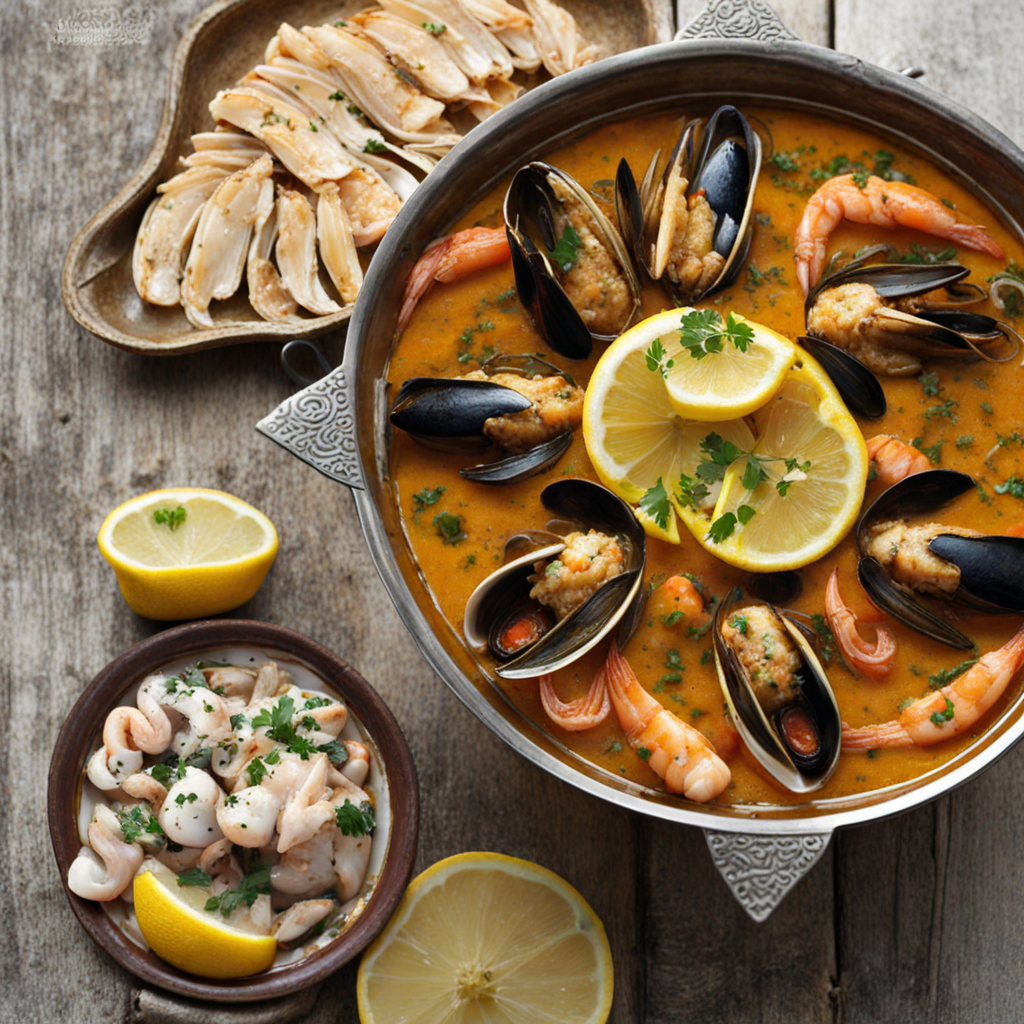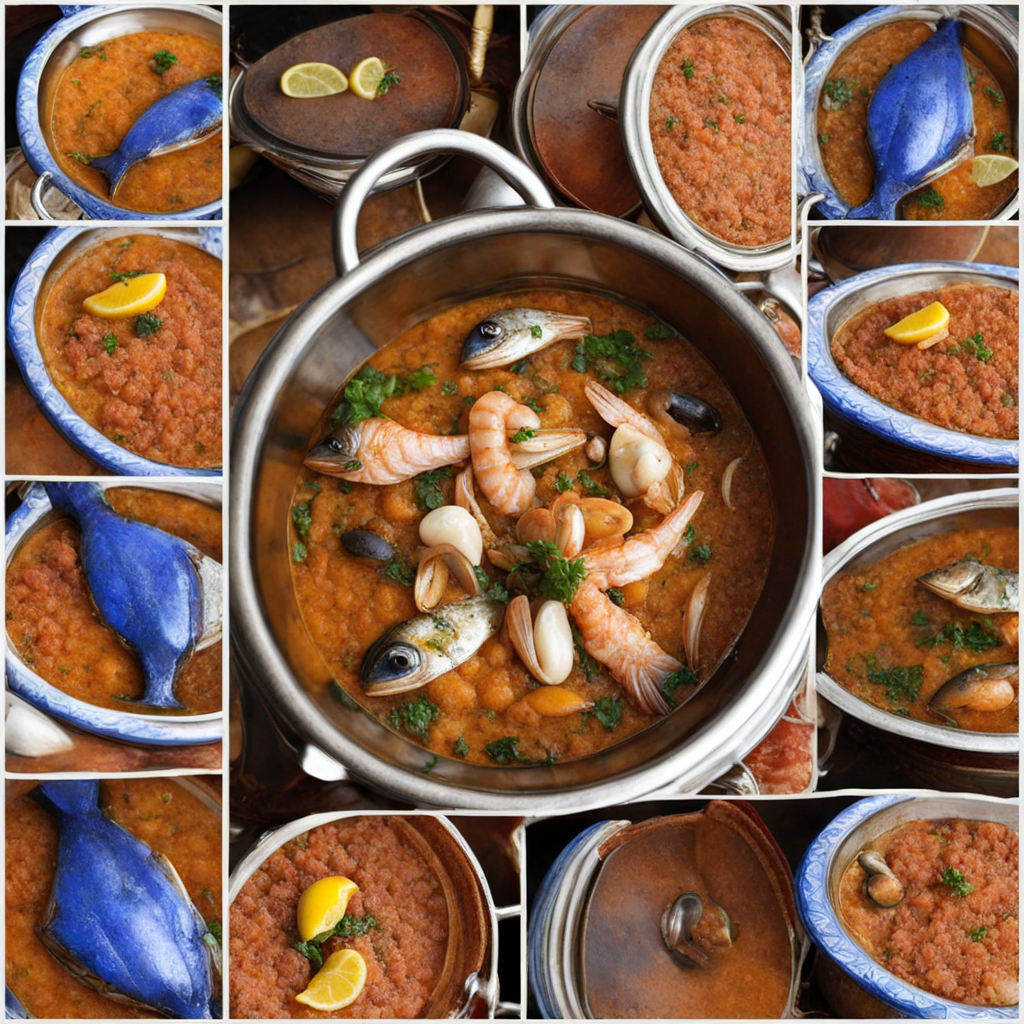Seafood Tagine
Seafood Tagine is a vibrant and aromatic dish that encapsulates the essence of Moroccan cuisine. This delightful stew is traditionally cooked in a conical clay pot known as a tagine, which allows the ingredients to simmer slowly, melding their flavors beautifully. The star of the dish is an assortment of fresh seafood, often including succulent shrimp, tender fish fillets, and plump mussels, all simmered in a rich, spiced broth. The use of spices like saffron, cumin, and paprika not only enhances the seafood but also infuses the entire dish with a warm, inviting aroma that beckons you to take a taste. Complementing the seafood are a medley of vegetables, such as bell peppers, tomatoes, and zucchini, which add color and texture to the dish. These ingredients are often sautéed with garlic and onions, creating a savory base that harmonizes with the natural sweetness of the seafood. A sprinkle of fresh herbs like cilantro or parsley on top adds a refreshing finish, making each bite a delightful balance of flavors. Citrus elements, such as preserved lemons or a squeeze of fresh lemon juice, provide a zesty brightness that cuts through the richness of the stew, elevating it to new heights. Seafood Tagine is typically served with warm, fluffy couscous or crusty bread, perfect for soaking up the delicious sauce. This dish offers an incredible sensory experience, combining the warmth of spices with the freshness of the sea, and the vibrant colors of the vegetables. Each mouthful transports you to the bustling markets and sun-drenched coasts of Morocco, making Seafood Tagine not just a meal but a cultural journey that celebrates the bounty of the ocean and the rich culinary traditions of the region.
How It Became This Dish
The History of طاجين السمك (Tajine of Fish) in Morocco Moroccan cuisine is a vibrant tapestry woven from various influences, reflecting the country's rich history of trade, conquest, and cultural exchange. Among its many culinary gems, طاجين السمك (Tajine of Fish) stands out as a delightful representation of Morocco's maritime heritage and its ability to blend flavors, techniques, and ingredients from diverse sources. The origins, cultural significance, and evolution of this dish offer a compelling insight into the soul of Moroccan gastronomy. #### Origins The word *tajine* refers both to the traditional earthenware cooking pot and the dish prepared within it. This unique vessel, with its conical lid, is designed to promote slow cooking, allowing flavors to meld beautifully while keeping the ingredients moist. The use of tajines dates back to ancient times, with archaeological evidence suggesting that they have been used since the Berber era. The origins of *طاجين السمك* can be traced to Morocco's extensive coastline along the Atlantic Ocean and the Mediterranean Sea, where fishing has been a vital part of life for centuries. Coastal cities like Essaouira and Agadir have long been hubs for fishing and seafood trade. The availability of fresh fish and the influence of various cultures—Berber, Arab, and Andalusian—shaped the culinary practices around seafood in Morocco. Traditionally, *طاجين السمك* was made using local fish varieties, such as sardines, mackerel, or grouper, depending on the region and season. The dish’s preparation often involves marinating the fish in a blend of spices, including cumin, coriander, paprika, and saffron, reflecting the spice trade that flourished in Morocco. The practice of marinating fish not only enhances its flavor but also showcases the Moroccan affinity for bold spices. #### Cultural Significance *طاجين السمك* is more than just a dish; it is a cultural emblem of Moroccan identity, particularly in coastal communities. The communal aspect of food is central to Moroccan culture, and *طاجين السمك* is frequently served during family gatherings or festive occasions. The act of sharing a tajine from a communal dish brings people together, fostering connections and conversations. Furthermore, seafood has played an essential role in the diet of coastal Moroccans, providing sustenance and economic opportunities. The fish markets, bustling with activity, are a testament to the maritime culture, where fishermen sell their daily catch and families purchase fresh fish for their meals. This connection to the sea imbues *طاجين السمك* with a sense of place and tradition, making it a dish that evokes nostalgia for many Moroccans. In addition to its communal and economic significance, *طاجين السمك* reflects Morocco's diverse culinary influences. The dish often incorporates elements from Mediterranean, Arab, and even sub-Saharan cuisines, showcasing the country's historical interactions with various cultures. For instance, the use of olives, preserved lemons, and harissa (a spicy chili paste) in some preparations highlights the blending of different culinary traditions. #### Development Over Time The evolution of *طاجين السمك* parallels the broader changes in Moroccan society and its culinary landscape. In the early 20th century, as Morocco faced colonial pressures and modern influences, the way food was prepared and consumed began to shift. Urbanization led to the rise of restaurants and cafes, where traditional dishes were adapted to cater to changing tastes and lifestyles. During this time, *طاجين السمك* saw variations in its preparation. While the traditional method involved simple marination and slow cooking, modern interpretations began to emerge. Chefs started to experiment with ingredients, incorporating seasonal vegetables like tomatoes, bell peppers, and zucchini, as well as distinct spice blends that reflected both local and international influences. This adaptability has allowed *طاجين السمك* to remain relevant in contemporary Moroccan cuisine. In recent years, the global interest in Moroccan food has surged, with *طاجين* becoming an iconic representation of the country's culinary heritage. International chefs and food enthusiasts have embraced *طاجين السمك*, often putting their own creative spins on the dish. This exposure has led to a renewed appreciation for traditional cooking techniques and the use of local, sustainable ingredients. Moreover, the growing awareness of the importance of preserving fish stocks and promoting responsible fishing practices has influenced how *طاجين السمك* is prepared. Many chefs and home cooks are now prioritizing the use of sustainably sourced seafood, ensuring that the dish not only remains delicious but also supports environmental stewardship. #### Conclusion *طاجين السمك* is a dish that encapsulates the essence of Moroccan cuisine—its depth, diversity, and cultural richness. Its origins are deeply intertwined with the country’s geographical and historical context, revealing the profound connection between the people and the sea. As a symbol of communal dining, it fosters togetherness and celebration, embodying the spirit of Moroccan hospitality. Over the years, *طاجين السمك* has evolved, adapting to changing culinary landscapes while retaining its traditional roots. The dish serves as a reminder of Morocco's maritime heritage and the importance of sustainable practices in preserving its culinary future. Today, whether enjoyed in a bustling seaside market or a cozy home kitchen, *طاجين السمك* continues to delight palates and tell the story of a nation that honors its past while looking toward the future.
You may like
Discover local flavors from Morocco







